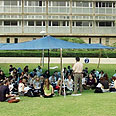
280,000 students this fall
צילום: שאול גולן
Back to college: More students, less lecturers
Ahead of opening of higher education academic year next week, Council for Higher Education presents data showing 3% rise in number of university students in Israel this year
Some 280,000 students will start the academic year on Sunday at higher education institutes around Israel, with a 3% rise in the number of university and college students in Israel compared to last year.
Despite the growing number of students, the number of lecturers teaching them continues to shrink each year. While the student-teacher ratio was 16:1 some 20 years ago, there is now one lecturer for every 24 students.
Data revealed at a press conference held by the Council for Higher Education on Wednesday showed that there are currently 221,420 undergraduate students, 47,300 graduate students, 10,300 doctorate students and 980 students working for diplomas.
Only 8.6% of the students are studying Humanities, compared to 18.5% just 10 years ago.
The numbers also showed that the global economic crisis that affected the high-tech branch among others, partially led to a drop in the number of students of mathematics, statistics and computer sciences.
There was also a drop in then field of education this year, from 16% of Israel's students studying education in recent years, to 13% this year.
More Arab students
As expected, the university budget cuts have also led to more packed classrooms. Changes occurring over the past few years in the number of students on the one hand and the number of senior staff on the other, have lead to more students per senior staff member.Ten years ago the number of senior staff positions available stood at 4,684. Since then, this number has gradually declined and in now stands at 4,300 – an 8% drop.
A similar trend was recorded in the number of openings for junior staff positions as well. The number dropped from 2,312 jobs 10 years ago to 1,905 jobs this last year – an 18% drop.
Meanwhile, an increase in the number of positions open to external lecturers has been noted, from 1,286 a decade ago to 1,543 last year – a 20% rise. External lecturers cost universities less, since they are employed as temporary employees with temporary contracts that are renewed every few months.
The percentage of Arab students studying for their first degree remains relatively low, but continues to rise. The latest numbers show that 11% of the first degree students are Arab, compared to 7% one decade ago.
Recent years have also seen a rise in the rate of Arab students working towards their second degree. Last year, 6.4% of all graduate students in Israel were Arab.










